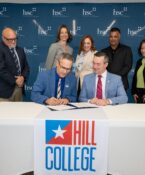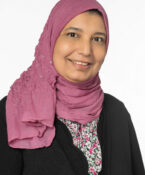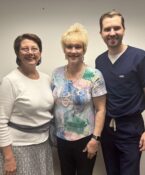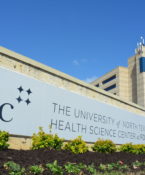For high school program, the goal is inspiration
By Eric Parker

“I really want to be a pediatrician!” said 14-year-old Albert.
He’d just finished listening via stethoscope to a heartbeat. Not just one heartbeat, but an array of normal and abnormal ones, including a malfunctioning valve.
It was a moment among many as 100 ninth-graders visited labs and classrooms at UNT Health Science Center to learn more about science and medicine. They’re eager participants in the annual Texas Academy of Biomedical Sciences (TABS) Summer Bridge program.
“I really liked how open to questions and helpful all of the teachers are,” Albert said. “These lessons helped me learn some really interesting stuff.”
The goal is inspiration, from the suture clinic where the students practice sewing up wounds to the anatomy lab where they can see human organs.
“They couldn’t believe the organs and bones were real,” said Maricela Zambrano, a Spanish teacher at TABS.
TABS students can earn dual college credit in high school as they prepare for higher education in the health sciences. The program is a collaboration among UNTHSC, the Fort Worth Independent School District, the University of North Texas and Tarrant County College.
The program is designed to give rising high school students an introduction to the educational opportunities available at a health science center while simultaneously emphasizing possible careers in medicine and biomedical science.
The UNTHSC Center for Anatomical Sciences staff coordinates the tours. UNTHSC students and faculty present information and provide activities to teach the TABS students about their respective fields.
Rachel Menegaz, PhD, Assistant Professor of Physiology & Anatomy, says the kids surprise her every year.
“In the reflexes clinic, a lot of the students had good questions about being double-jointed,” Dr. Menegaz said. “Every time I do sessions with transitioning middle schoolers, I’m always impressed by how much they know. Most of the kids are able to articulate specific ideas about their future careers as a result of their TABS experience on our campus.”
The four-day camp concluded with a White Coat Ceremony in which students donned white coats to celebrate their transition from middle school to high school.
“It’s a great team-building event with a good sense of camaraderie,” said TABS world history teacher Patrick Crawford. “These kids come from all over the city, so this introduces them to each other and starts to build friendships.”
In the suture clinic, 14-year-old Dylan asked, “How come when the doctor does stitches it looks like X’s?” as he tried to replicate something called a simple interrupted suture pattern.
“There are different types of suture stitch patterns depending on the wound being closed,” responded volunteer leader Emily Tutt. “There are actually hundreds of different stitch patterns doctors and surgeons can use.”
The kids’ week on campus is packed with visits to the gross anatomy lab, simulation lab, movement lab, forensics lab, eye institute, physical therapy rehab lab and research labs.
“Each year, at the end of the weeklong program, when these children are asked how many of them would be interested in becoming a health professional or a scientist … the majority will raise their hands,” said Armando Rosales, MD, Associate Professor of Physiology & Anatomy. “And each time, we genuinely believe that we have ignited a spark of interest towards discovering career paths among these youths.”






Social media